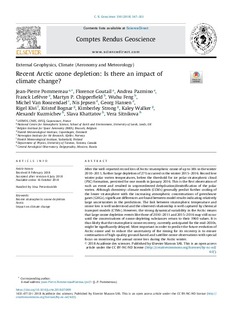| dc.contributor.author | Pommereau, Jean-Pierre | |
| dc.contributor.author | Goutail, Florence | |
| dc.contributor.author | Pazmino, Andrea | |
| dc.contributor.author | Lefèvre, Franck | |
| dc.contributor.author | Chipperfield, Martyn P. | |
| dc.contributor.author | Feng, Wuhu | |
| dc.contributor.author | van Roozendael, Michel | |
| dc.contributor.author | Jepsen, Nis | |
| dc.contributor.author | Hansen, Georg Heinrich | |
| dc.contributor.author | Kivi, Rigel | |
| dc.contributor.author | Bognar, Kristof | |
| dc.contributor.author | Strong, Kimberly | |
| dc.contributor.author | Walker, Kaley | |
| dc.contributor.author | Kuzmichev, Alexandr | |
| dc.contributor.author | Khattatov, Slava | |
| dc.contributor.author | Sitnikova, Vera | |
| dc.date.accessioned | 2019-02-05T10:10:44Z | |
| dc.date.available | 2019-02-05T10:10:44Z | |
| dc.date.created | 2018-11-20T11:03:41Z | |
| dc.date.issued | 2018 | |
| dc.identifier.citation | Comptes rendus Geoscience. 2018, 350 347-353. | nb_NO |
| dc.identifier.issn | 1631-0713 | |
| dc.identifier.uri | http://hdl.handle.net/11250/2583887 | |
| dc.description.abstract | After the well-reported record loss of Arctic stratospheric ozone of up to 38% in the winter 2010–2011, further large depletion of 27% occurred in the winter 2015–2016. Record low winter polar vortex temperatures, below the threshold for ice polar stratospheric cloud (PSC) formation, persisted for one month in January 2016. This is the first observation of such an event and resulted in unprecedented dehydration/denitrification of the polar vortex. Although chemistry–climate models (CCMs) generally predict further cooling of the lower stratosphere with the increasing atmospheric concentrations of greenhouse gases (GHGs), significant differences are found between model results indicating relatively large uncertainties in the predictions. The link between stratospheric temperature and ozone loss is well understood and the observed relationship is well captured by chemical transport models (CTMs). However, the strong dynamical variability in the Arctic means that large ozone depletion events like those of 2010–2011 and 2015–2016 may still occur until the concentrations of ozone-depleting substances return to their 1960 values. It is thus likely that the stratospheric ozone recovery, currently anticipated for the mid-2030s, might be significantly delayed. Most important in order to predict the future evolution of Arctic ozone and to reduce the uncertainty of the timing for its recovery is to ensure continuation of high-quality ground-based and satellite ozone observations with special focus on monitoring the annual ozone loss during the Arctic winter. | nb_NO |
| dc.description.abstract | | nb_NO |
| dc.language.iso | eng | nb_NO |
| dc.rights | Attribution-NonCommercial-NoDerivatives 4.0 Internasjonal | * |
| dc.rights.uri | http://creativecommons.org/licenses/by-nc-nd/4.0/deed.no | * |
| dc.title | Recent Arctic ozone depletion: Is there an impact of climate change? | nb_NO |
| dc.type | Journal article | nb_NO |
| dc.type | Peer reviewed | nb_NO |
| dc.description.version | publishedVersion | nb_NO |
| dc.rights.holder | © 2018 Académie des sciences. Published by Elsevier Masson SAS. This is an open access article under the CC BY-NC-ND license. | nb_NO |
| dc.source.pagenumber | 347-353 | nb_NO |
| dc.source.volume | 350 | nb_NO |
| dc.source.journal | Comptes rendus Geoscience | nb_NO |
| dc.identifier.doi | 10.1016/j.crte.2018.07.009 | |
| dc.identifier.cristin | 1632524 | |
| dc.relation.project | NILU - Norsk institutt for luftforskning: 113007 | nb_NO |
| cristin.unitcode | 7460,57,0,0 | |
| cristin.unitname | Atmosfære og klima | |
| cristin.ispublished | true | |
| cristin.fulltext | original | |
| cristin.qualitycode | 1 | |

